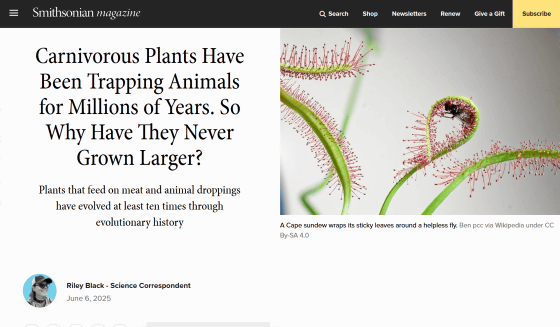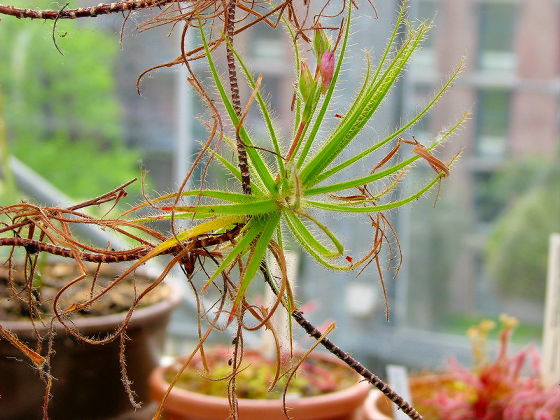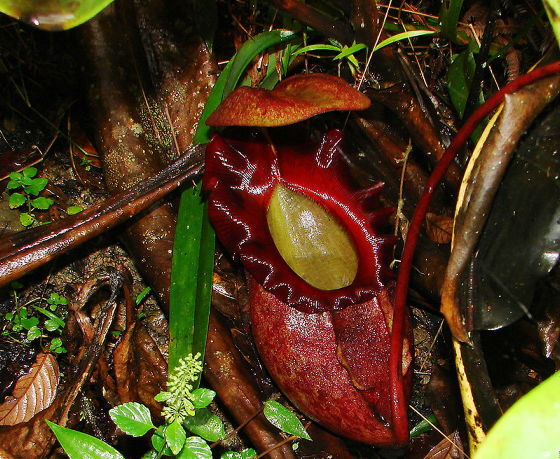Why didn't carnivorous plants grow large enough to eat humans?

There are many types of
Carnivorous Plants Have Been Trapping Animals for Millions of Years. So Why Have They Never Grown Larger?
https://www.smithsonianmag.com/articles/carnivorous-plants-have-been-trapping-animals-for-millions-of-years-so-why-have-they-never-grown-larger-180986708/

Carnivorous plants, which prey on insects and other small animals, are fascinating, and some science fiction works feature carnivorous plants large enough to prey on humans. However, despite the fact that carnivorous plants are found all over the world and have a variety of feeding mechanisms, no species large enough to prey on humans has been found to date.
To understand why there are no giant carnivorous plants, we need to understand their evolutionary origins. Plants absorb the water and nutrients they need to survive from the soil, and can also produce nutrients through photosynthesis. However, some plants cannot meet their needs through photosynthesis or nutrients from the soil alone, and some plants have evolved to use small animals and their excrement as a source of nutrition.

The oldest carnivorous plant fossil ever found was preserved in amber more than 34 million years ago. The fossil showed not only normal leaves but also tentacle-like protrusions. Although the plant itself does not belong to any known species, it was very similar to a carnivorous plant native to South Africa called
Roridula captures insects with sticky projections on its leaves, and uses the excrement of stink bugs ( Pameridea roridulae ) that prey on the insects as its source of nutrition. Pameridea roridulae has a symbiotic relationship with Roridula, spending its entire life on the plant and helping with pollination. The fossils found in amber are thought to have used the insects they captured as food to lure scavengers, and used the excrement as a source of nutrition, just like Roridula.
'When I first looked at these amber-encased fossils under a microscope, I couldn't believe what I was seeing,' said Alexander Schmidt, a paleontologist at the University of Göttingen in Germany, who reported on the fossils in a 2014 paper .
The photo below shows Loridula. You can see that there are countless protrusions on the surface of the leaves.

by ekenitr
While Loridula used animal waste as a source of nutrition, there are many other methods used by carnivorous plants. For example, Drosera rotundifolia secretes mucus from the hairs on its leaves to capture insects, then uses enzymes to digest and absorb them. The pitcher plant has a cylindrical insect-trapping pouch made from a modified leaf, into which it digests insects, small animals, and sometimes animal waste that slide down, using digestive juices that accumulate at the bottom.
A type of carnivorous plant, the pitcher plant, has evolved into a 'living toilet' that eats animal feces instead of insects - GIGAZINE

In addition, when an insect touches the sensory hairs on the inside of the two open leaves of a Venus Flytrap, it closes the leaves in just 0.5 seconds and slowly breaks down the insect using digestive juices secreted from the leaves. You can watch videos of Venus Flytraps catching insects on YouTube and other sites.
Top 20 / Venus flytrap - Venusfliegenfalle - YouTube
According to Eva-Maria Sadowski, a botanist at the Berlin Museum of Natural History, carnivorous plants are thought to have evolved in some form at least 10 times, but the swamps and moist forests where they grow are difficult to preserve as fossils because the soil is relatively acidic, making it difficult to trace their history.
Therefore, when studying the evolutionary history of carnivorous plants, it is important to focus on pollen, which is more likely to remain as fossils than leaves or flowers. The oldest pollen in the carnivorous plant group dates back to the Eocene epoch , 33.9 million to 55.8 million years ago, and the most diverse family is the Droseraceae . 'The fossil record of the Droseraceae family is the richest of any carnivorous plant lineage,' says Sadowski.
The largest carnivorous plant found to date is Triphyllium peltatum , a vine native to West Africa that can grow to lengths of over 50 meters. However, Triphyllium peltatum only has carnivorous leaves like sundew for a short period of time while it grows along the ground, and by the time it attaches itself to a tree, it no longer has any carnivorous behavior.
In addition, on the island of Borneo in Southeast Asia, there is a large pitcher plant called Nepenthes rajah , whose pitcher pouches reach a depth of about 41 cm, and which sometimes catch small vertebrates such as lizards and frogs. However, these are still nowhere near the size required to eat humans.

By Dick Culbert
The reason why these carnivorous plants do not grow large enough to eat humans is that they grow in nutrient-poor soil. Because the plants that grow in these soils cannot obtain sufficient nutrients from the soil, they have developed various predatory mechanisms to use insects as a source of nutrition. In other words, the purpose of carnivorous plants catching insects is to make up for the lack of nutrients.
However, in order to have the mechanism to prey on large animals like humans, the plant itself must first grow large. Plants need nutrient-rich soil to grow large, but plants that grow in such soil have no need to become insectivorous to compensate for nutrient deficiencies in the first place. Therefore, there are no carnivorous plants large enough to eat humans.
'Carnivorous plants don't just eat animals for themselves. This adaptation is an amazing way to thrive in environments where they would be otherwise difficult to grow,' said Black. 'Carnivorous plants already gather in wetlands around the world, borrowing the nutrients they need from other living organisms and surviving at the edge of their adaptations. So they don't need to grow to the gigantic sizes you see in horror movies.'
Related Posts:






